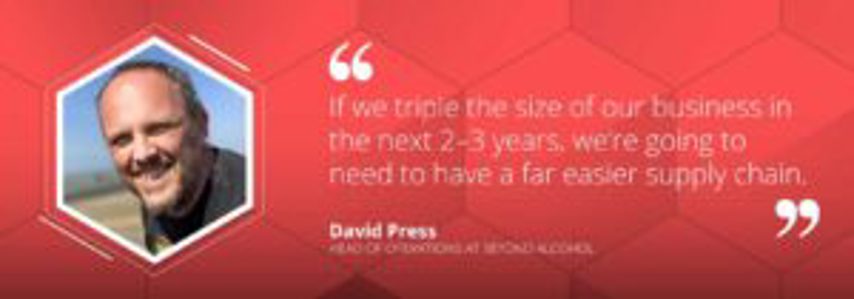
In part 2 of our SME Supply Chain Resilience roundtable, we ask our experts how to maintain system agility when your business is scaling in a compromised supply chain. These are their 18 techniques.
Meet our supply chain roundtable experts:
- Daniel Bull-Clearie is Head of Supply Chain at Mara Seaweed, an Unleashed Customer that makes seaweed products.
- Sam Gilks is a Supply Chain Consultant at Young Foodies, which offers services to FMCG challenger brands.
- Philip Oakley is Managing Director of Outserve, an Unleashed partner that provides software integration services.
- David Press is Head of Operations at Three Spirit, another customer which produces plant-based alcohol alternatives.
- Ben Vear is General Manager (EMEA) for Minor Figures, an Unleashed customer that specialises in oat milk and coffee products.
1. Forecasting demand
Forecasting demand is a key – perhaps the key – action you can take to scale your business and pre-empt supply chain problems. It may sound simple, but it’s not – and lead times and shortages will need to be tracked and updated constantly. If your business is operating in different areas – perhaps different countries – it's about refining your forecast to each of these. David from Three Spirit, for example, says they always know “minimum stock levels within each of those locations, forecast sales within each of those areas, understanding what lead times are or the agility of the 3PLs to ensure that we’ve got finished goods within those areas.”
2. Scaling your planning horizon
Forecasting is key; and as you scale, your forecasting horizon should expand to match your business’s growth. How you do this will also depend on strategic aims for the period in question. As Sam Gilks from Young Foodies puts it: “It’s very different depending on where in the stratosphere you sit and what your strategic aims are for that business cycle. “A small business is probably looking on a 3, 6 or 12 month horizon, maximum. And as you scale up you start to blow that out to at least 24, maybe even 36, months – obviously challenging at the moment with what’s going on in the world.”
3. Keeping pace with category growth
As your business grows, look to how your product category is developing and keep pace with it if you can. For Mara Seaweed, which makes seaweed seasonings, Daniel says there is still work to do on customer education and R&D as the company establishes itself, as well as capital investment to facilitate planned growth. Daniel says it’s a question of making sure you don’t grow more than the market can bear, “but equally, you are keeping your position at the forefront and helping that market to go on supplying demand as it increases.” A cautionary tale is provided by the dairy alternative category. As Ben Vear puts it: “Business is keeping up with category growth, and category growth keeping up with manufacturing bases?. Dairy alternatives haven’t, so they’ve outgrown the capacity globally of manufacturers.” The lesson? SMEs need to walk the line between aligning with category growth and running out of stock. 
4. Community and information-sharing
A strong theme that comes through from our roundtable is the reliance on community and mutual support among SMEs – especially when they’re scaling. Sam Gilks says Young Foodies, for instance, has a team dedicated to community, as well as a platform where challenger brands can ask each other about their respective markets: “Who’s the buyer at M&S in this category? You can literally ask that question on our platform and find the answer, rather than trawling LinkedIn or trying to dig around.” He adds: “If you don’t know the answer, go network, go find out who does – and you will save yourself a lot of grief.” 
5. Using professional services
Organisations like Young Foodies offer professional services to help challenger brands compete in their market, such as supply chain expertise, recruitment and training. The company also provides a way to network with other SMEs by providing a platform where a community can develop (see #4 above). Sam says this is at the core of what they do – and the reason the company exists: “The reason Young Foodies exists is to help as a platform for our community of brands or community of challenger brands to accelerate their growth. “I think that probably the core of what we do is our community. It’s not supply chain or what I do – it’s supporting that community of brands to accelerate their growth into the markets and just take that market share.”
6. “You can steer yourself onto the rocks if you don’t know where you stand”
A classic piece of supply chain advice is to do an audit – and this becomes even more important as your company scales. Sam Gilks, a supply chain consultant, says this is something he would often advise growing businesses to do: “We would tend to push people to run a supply chain audit when they’re trying to retail ramp. It’s very different from a kitchen table to a retail solution. “So we would do a ready-to-supply audit, and we would really encourage people to know exactly the ground they stand upon – cognizant of the fact that the ground is constantly shifting at the moment, so it’s not just that simple.” 
7. Matching marketing to growth
Marketing is another aspect to focus on when supply chains are compromised, again requiring planning, budget and the right personnel to see it through. Mara Seaweed, for instance, is currently grappling with questions about how to gain a foothold in the market: Should they target the B2C market, with customers who are unfamiliar with their novel products? Or should they focus on another category as knowledge of their product grows? Which social media channels should they use? As supply chains falter, SMEs will have to strike a balance between investing in marketing, and committing working capital to investment in more stock holding and facilities that will allow them to grow.
8. Dealing with viral demand
Most businesses can plan for a gradual increase in demand for their products, but what happens when your product goes viral – whether that's down to your own marketing, or occurs organically due to customers’ enthusiasm for your product? David Press from Three Spirit has been in this very position, and while he describes this sort of customer engagement as ‘fantastic’, it has led to some tricky situations: “When you are small and growing, and you are putting product down expecting it to last you a period of time and finding that it’s gone in half of that horizon, you’re then left with awkward conversations with the sales team – and some fairly poor strategic positioning with your manufacturing and ingredient people where you’re basically just trying to get ingredients in.” Three Spirits’ solution? Go back to their inventory and stock build to factor in this sort of possibility – alongside all the other supply challenges they’re facing these days.
9. Upgrading production facilities
Investment in bigger or better facilities to make supply as you scale easier will depend on what capital you have available, but it can pay off in the long term if you’re able to do it. This is a step Daniel Bull-Clearie says Mara Seaweed is taking to improve production – and at the same time improved technology is helping to decrease costs: “We’re going through this relocation and scale-up from our current small-scale factory to a bigger one I’m introducing, which will give us the capacity to increase our volumes quite significantly and reduce our costs.” 
10. “We can be this niche, we can grow”
Are your products so niche that your business cannot scale with them? And if you grow further in years to come, can you deliver that growth? David Press says this is a lesson that’s been learnt at Three Spirit through experience: “I think when the business started a few years ago, it was seen as, “We can be this niche, we can grow.” Now all of a sudden we have grown from where we were to where we are now, and we can see that if we triple the size of our business again in the next 2–3 years, we’re going to need to have a far easier supply chain, and a far easier source of supply of those ingredients to ensure that we can actually deliver that growth.” 
11. To off-trade or not to off-trade?
Should you go into the off-trade, or not? That’s another strategic question to ask when your business is scaling so your supply chain can keep up. For David Press from Three Spirit, the key is being cautious and having controlled growth in the off-trade area, while other areas deliver steady growth: “We as a business are cautious in where we are looking to put ourselves, especially in the off-trade. We’re not looking to go into the major multiples at this current time – we don’t want to do that at the moment, and that’s a strategic decision for us when you’re gaining margins for 90% of your business through a D2C community.”
12. Different cadences for different markets
Don’t be afraid to run your business at different cadences to suit each market – and each supply chain – as you expand. Minor Figures provides a good example of this, having built up the business in coffee shops around the UK. Ben Vear comments: “Our business is quite unique because we are at different cadences in different markets. So our business in Australia is much more developed, and we are 100% grocery distribution in the duopoly of Woollies and Coles. “In the US, we’re very much at the start of our journey in coffee, and in the UK, we are far along in our coffee journey, but just entering retail. So it’s really interesting – a business that’s running at all these different speeds at the same time.” 
13. Optimising your supply chain in terms of location
As you move into new markets, optimise your supply chain for that particular location to reduce supply chain vulnerability. Three Spirit has set up production sites in the US to enter that market, and David Press says they are now “looking at how you optimise the operational, physical supply chain in terms of geographic locations.” Minor Figures is likewise localising its supply chain as it expands: “One of the strategies we have been using to be able to keep pace is to localise supply chains,” Ben says, “So we’ve now got manufacturing in Australia, we’ve now got manufacturing in North America, and we’ll expand that across to another site in Europe as well.”
14. Tackling America: 'Eating the Elephant'
Within a huge market like the US, more granular localisation is key. David sums it up neatly: “It is very easy to go wrong and expect that you can eat the elephant in one go. It’s not the case. You really do have to do it small piece by small piece.” “The US is a massive market, and as a business, they’re going to want to separate out so that we’ve got more localised supply perhaps in the north-east of the US, perhaps on the west coast in California, perhaps down towards Florida. And making sure that we’ve got the ability to scale – both in terms of the materials, and in systems.” Minor Figures has operations based on both the east and west coasts, and Ben Vear also notes how pricey shipping within the US can become: “Particularly interstate, logistics is incredibly expensive.” 
15. Expanding in the EU with multiple locations
The EU market presents its own challenges as you expand – among which is establishing a reliable supply chain. Three Spirit has a VAT registration in the Netherlands, for instance, but David Press says that to expand to more locations, they’ll need to find a supply from other parts of Europe, such as Germany, Spain, Scandinavia and France. David also makes the point that it’s important to have the right financial and tax support systems in place when you make this move, to ensure you “don’t get burnt”.
16. The pitfall of solely chasing sales metrics
It’s exciting when your sales metrics are looking healthy as your business scales – but it's dangerous to make the mistake of focusing on these and neglecting proper supply chain planning. “I think Sam’s really right,” Ben says, “in that the tendency in a lot of scale-ups is to chase sales metrics, and often supply can be a secondary thought. But of course, if you don’t have supply, then those sales just collapse.” 
17. Choosing software that can scale
There are now numerous options when it comes to software, and choosing the right option – i.e one that can scale – is a huge part of managing supply Philip Oakley puts it in a nutshell: “Absolutely great software is part of the solution, but also trying to understand which great software you should be using, how it should be integrated, and then the ability to scale and how it all works together.” To optimise your system you’ll want the right systems, data and reporting capacity – which can involve the question of what and when you should outsource jobs. 
18. Juggling factors that put pressure on your supply chain
To round things off, appraising the numerous factors in play affecting your supply chain is central to overcoming challenges as you scale. Minor Figures – which produces oat milk – is an example of this. Recent events in the Ukraine, which provides much of the sunflower oil used in dairy alternatives, has put pressure on supply. At the same time, the brand has launched in Tesco nationwide, adding to the pressure. Ben Vear says the company has responded by maintaining higher levels of inventory – but this does tie up cash, and it’s still hard to predict what stock will be needed: “We’re holding additional stock. We work to quite a tight tunnel of inventory that we want to keep in stock, and that might be four to six weeks. But when your performance needle is constantly moving, it’s tough to get a read on what four to six weeks of stock looks like.”
- Watch Part 1 of the Supply Chain Roundtable: Supply Chain Resilience and Mitigating Risk
